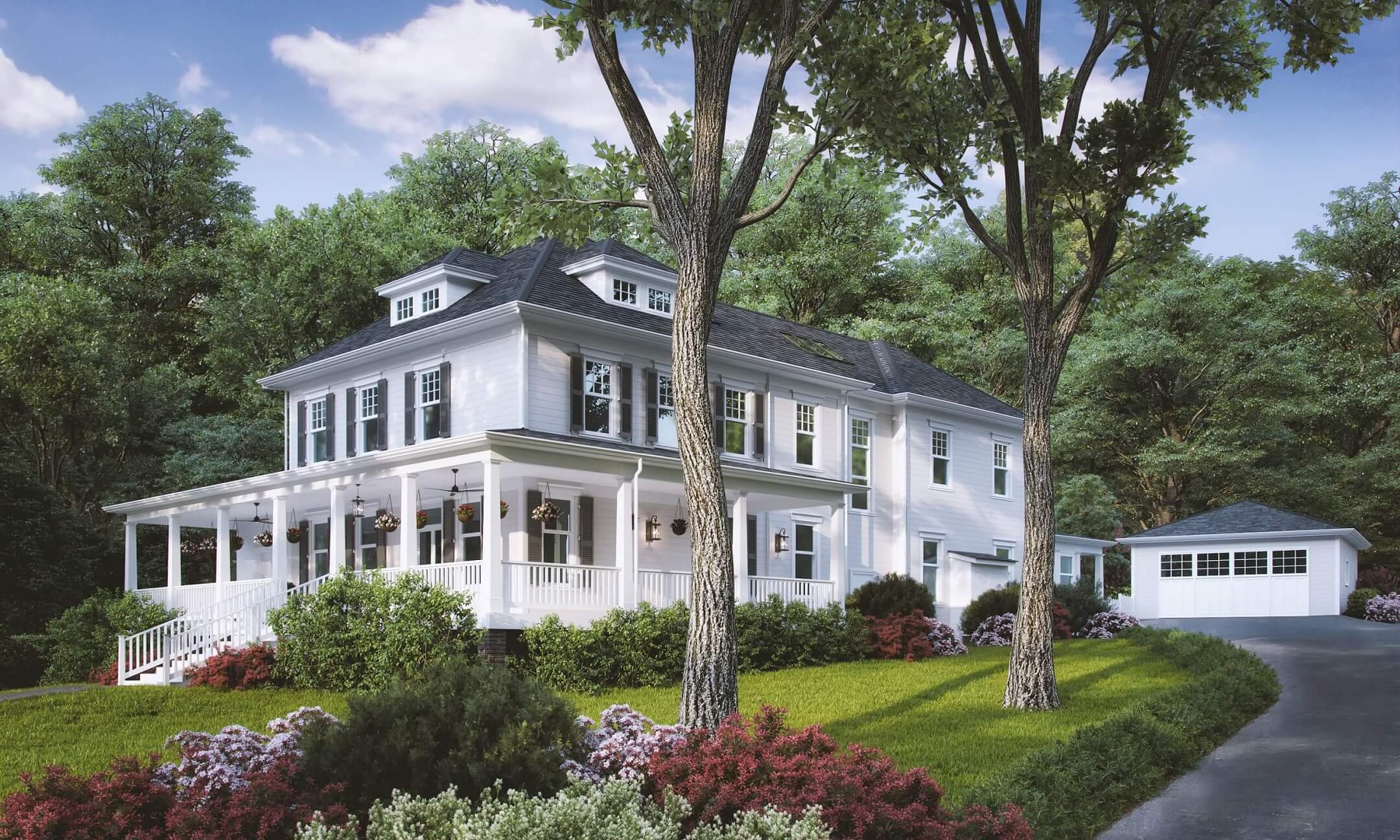Setting and achieving professional goals in the architecture business takes more than commitment. It also requires a strategy. And to develop one that really works, it’s best to get a consultation with a guide who has excellent experience in the field. Karen Fugle, the founder of SleepingGiant Consulting, provides architects and designers with that sort of guidance.
Karen used to be a leading UK CAD & BIM consultant. Then, she decided to switch her career to coaching architecture and design experts and help them reach the professional heights they dream of. Karen can assist in plenty of situations: reaching career goals, improving leadership skills, removing overwhelm at work, and more. In any of those cases, Karen helps architecture industry players gain and sharpen the skills required to balance things out and move forward with success.
Impressed by all the work Karen does to improve the well-being of architects, the team of our architectural visualization company couldn’t miss a chance to do an interview with her. In our talk with Karen, we covered burning topics of the architectural community. She answered our questions about becoming an effective team leader, dealing with stress, building architect-client relationship, and more. Want to find some professional tips on how to improve your architectural practice? Then read on!
Karen, you have an impressive career in the architectural sector. We know that you’ve been a CAD & BIM consultant. Why did you decide to switch to mentoring and coaching?
Leaving an excellent career for another one is never an easy choice nor a smooth ride! I realized two things: I was not getting my creative values met by writing BIM strategies and programming. Secondly, architects were missing the kind of support that helps them navigate through career challenges.
The last UK recession brought this home when it became clear that technology was the architect’s upper hand. So, business was good for BIM, but on the flip side, I saw many redundancies. I had to ponder then – was it the technology I liked working with, or the people? Eventually, I chose the people and their well-being, which set me on an unplanned path to Executive Coaching. I feel privileged to have worked with many talented people during my CAD/BIM career. I can now work with them still, helping architects and construction professionals achieve even greater success.
Architects were missing the kind of support that helps them navigate through career challenges.
What do you think are the biggest global challenges in the work of modern architects and designers?

Probably not what you expect! We tend to think about technical challenges in this industry; however, it is the people that need to change. By looking at our collaborative behaviours, relationships, attitudes towards conflict, we can make a real change in performance.
A more immediate challenge is hybrid working. Now that we are getting back into the offices and bringing in long-overdue flexible working policies, we will have more meetings with a combination of attendees – those in the office, those at home, those in other spaces or countries, all together. Pre-COVID, I had meetings where, as a “dial-in” participant, I was looking at the ceiling, and my voice was either lost or forgotten by the people in the room. We need to work on how to give equal and meaningful participation in a hybrid workspace.
We tend to think about technical challenges in this industry; however, it is the people that need to change.
What types of clients do you have in your coaching practice? Do you usually work with individual architecture and design experts or with whole teams?
All my clients are aware that they can work more efficiently or joyfully, and they have the motivation to do something about it. So, I might work with a company to figure out their business values, an architect who wants to be a better leader or a solo business owner who needs me as a sounding board and help to look at the business strategically. To ‘type’ my clients, it’s a 50/50 mix of mid to senior-level leaders in the larger design organizations and small business owners.
What professional issues do your clients ask for help with most often?
Everyone has a bespoke need for a coach; however, I do work with many transition clients. That is, those who want to move on but don’t know where to. It may be that they are not getting promoted or finding the right opportunities in the company they are in or have lost the joy in what they are doing. We get back to the foundation for good decision making – your values, then establish a way forward, say goodbye well and transition into a new and better position. The second main issue I work with is managing the team. We aren’t taught these leadership skills, and knowing how to engage, motivate, and create inclusive spaces helps strengthen the team culture.
How important is it for architects and designers to use photorealistic 3D visualization and BIM technology nowadays? How exactly do both technologies help in their work?

3D rendering by ArchiCGI studio
90% of the information transmitted to the brain is visual, so why wouldn’t you want your projects to stand out from the crowd? Science tells us that the human brain can process an image up to 60,000 times faster than text. Giving your clients a photorealistic architectural visualization of the project creates excitement, commitment and investment. We can connect with an image emotionally and spatially. More importantly for you, it saves time, money and gives you more efficiency and control. BIM technologies make the design process much more transparent, allowing for errors to be spotted earlier, better decision-making and enhanced real-time collaboration. Being visual by nature, it makes sense to capitalize on the benefits of photorealistic 3D images and BIM technology.
Giving your clients a photorealistic visualization of the project creates excitement, commitment and investment.
Which soft skills are the most important to excel in the architecture industry?
I think there are many that count as necessary! Listening, for example. I mean, listening that deepens your conversations, develops your presence as a leader and helps your team collaborate more effectively. As an industry, we can’t keep talking about collaboration and improved quality of stakeholder relationships without adjusting our role as listeners. You have probably heard people talk about “active listening”, and it’s about giving good feedback as much as focusing with intent.
Empathy, vulnerability, courage are up there too. They all go hand in hand. You want your team to feel that they can set aside self-doubt and speak without being judged or criticized. And that means that leaders must be intentional about creating a safe space where people can share their mistakes and ideas and ask questions. That takes courage because leaders go first. You must be able to say: “I was wrong” or “I made a mistake”.
Leaders must be intentional about creating a safe space where people can share their mistakes and ideas and ask questions.
What are the main skills an architect or a designer should develop to become an effective leader in their team?
Leaders have got to balance the triangle of results, relationships and ego. If you overemphasize results, you may be coming across as too aggressive or uncaring. On the other hand, if you over-emphasize relationships, you may avoid saying what really needs to be said and paradoxically hurt the relationship. Being able to deliver good feedback is key to helping you keep this balance. Especially if you are like many folks I work with, conflict-avoidant in nature.
Showcase your architectural project like a true work of art, brought to life with cutting-edge AI-powered CGI technology.
Working in the architectural sector is challenging and can be stressful sometimes. What are your go-to tips on dealing with that stress effectively?
Science now tells us that what you think about stress matters a great deal. Stress alone doesn’t kill people, but the combination of stress and the belief that stress is harmful does. So, what is most helpful is adjusting your mindset towards stress. If you view stress as trying to help you, not hurt you, then your stress response becomes a resource that gives you more energy, confidence and a greater willingness to take action. My top tips are to:
- Recognize stress as valuable data – getting you ready to rise to a challenge.
- We need to release stress in the moment, rather than down the pub later, and the quickest route is to calm our breathing. Do this, and your heart will tell your brain that you are safe. Breathing helps you get into a more neutral state, and from there, you can think more objectively.
- Help the people in your team unpack their stress by defining what the stress is. Look at the amount of work, effort and difficulty, and the amount of control they have to prioritize or schedule that work.
Recognize stress as valuable data – getting you ready to rise to a challenge.
What are the main principles for building trust with existing and potential clients and overall improve the architect-client relationship?
I think a big key here lies in clarifying expectations. We assume that what we share is interpreted and understood in the way that we intended it. Within this lies some integrity – being honest about what you want. However, the reality is often that the other party has arrived at a different set of assumptions and actions. A couple of good questions such as: “What have you understood from this conversation?” or “What do you see as your/my next steps?” can go a long way in avoiding problems further down the line. There is a book that I recommend you read: The Speed of Trust by Stephen Covey that outlines some 13 behaviours, from talking straight to delivering results to practicing accountability.
What would be your primary advice for an architect or designer whose goal is to become not just a top-tier professional but an influencer in the field, the one who inspires and motivates others?
My advice is to know your leadership journey – what kind of leader you want to be and how you got to this point. Reflect on what leadership influences you had as a child. Explore what good and bad leadership look like. Discuss what you have learned from the leaders you’ve worked with. What leaders do you admire, and what advice would they give you? How have these experiences impacted your beliefs about leadership? What is your leadership approach, and how do you put it into practice now? Many questions that I suggest are worth exploring to become, intentionally, the authentic leader and influencer you wish to be.
In the course of our talk, Karen addressed issues that are important for every architect and designer. She gave pro tips on becoming a leader, gaining trust, and dealing with stress. We hope this interview with Karen will help you find some actionable tips for reaching your professional goals.
Our team is very grateful to Karen Fugle for sharing a bit of her profound experience with our readers and us. We wish her great success in her ongoing work and further projects.
Need irresistible marketing or presentation visuals for your architecture and design projects, such as office 3D rendering or residential rendering? Contact ArchiCGI for professional 3D visualization services and get photoreal and atmospheric CG images that will help you to win your prospects’ hearts right away!
Catherine Paul Catherine is a content writer and editor. In her articles, she explains how CGI is transforming the world of architecture and design. Outside of office, she enjoys yoga, travelling, and watching horrors.

Content Writer, Editor at ArchiCGI



